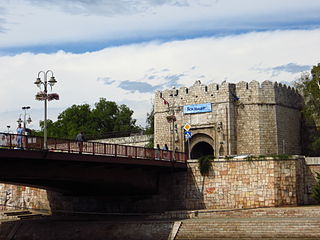Related Research Articles

The Sultanate of Rûm was a culturally Turco-Persian Sunni Muslim state, established over conquered Byzantine territories and peoples (Rûm) of Anatolia by the Seljuk Turks following their entry into Anatolia after the Battle of Manzikert (1071). The name Rûm was a synonym for the medieval Eastern Roman Empire and its peoples, as it remains in modern Turkish. The name is derived from the Aramaic (rhπmÈ) and Parthian (frwm) names for ancient Rome, via the Greek Ῥωμαῖοι (Romaioi).

Hurufism was a Sufi movement based on the mysticism of letters (ḥurūf), which originated in Astrabad and spread to areas of western Iran (Persia) and Anatolia in the late 14th and early 15th centuries.

Süleyman Pasha was the eldest son of Orhan, the second ruler of the newly established Ottoman Empire. His mother was either the concubine Nilüfer Hatun or, more probably, the consort Efendize Hatun. He played a major role in early Ottoman expansion into Thrace in the 1350s. He died in a hunting accident in 1357.
Dawūd al-Qayṣarī was an early Ottoman Sufi scholar, philosopher and mystic. He was born in Kayseri, in central Anatolia and was the student of the Iranian scholar, Abd al-Razzaq Kāshānī.
The fire of Skopje started on 26 October 1689 and lasted for two days, burning much of the city; only some stone-built structures, such as the fortress and some churches and mosques, were relatively undamaged. The fire had a disastrous effect on the city: its population declined from around 60,000 to around 10,000, and it lost its regional importance as a trading centre. Many of them settled in the imperial capital of Istanbul, creating the Üsküp mahallesi.
Mulla Shams ad-Din Muhammad ibn Hamzah al-Fanari, 1350–1431, known in short as Molla Fenari was an Ottoman logician, Islamic theologian, Islamic legal scholar, and mystical philosopher of the school of Ibn ʿArabī.

Niš Fortress is a fortress in the city of Niš, Serbia. It is a complex and important cultural and historical monument. It rises on the right bank of the Nišava River, overlooking the area inhabited for longer than two millennia. It was protected by law in May 1948 as it was declared a cultural site of great significance. The current condition of the fortress lists it as one of the best preserved fortifications of this kind in Serbia as well as on the Balkan Peninsula.
The İslâm Ansiklopedisi (İA) is a Turkish academic encyclopedia for Islamic studies published by Türkiye Diyanet Foundation.

Hak Dini Kur'an Dili written by Muhammed Hamdi Yazır, Turkish Islamic theologian born in Antalya, Turkey. Hak Dini Kur'an Dili was ordered by Mustafa Kemal Atatürk. It is the first Qur'an translation in Modern Turkish.
The Rast pitch class set is a set of scales that are named after the Rast makam. For Rast, there is the Rast tetrachord and Rast pentachord.
Basit Suzinak is a makam in Turkish makam music. It is in 53 Tone Equal Temperament.
Nikriz is the a scale in Turkish makam music. It is in 53 Tone Equal Temperament.
In Turkish music, the hicaz pitch class set is a set of scales that are named after the Hicaz Turkish makam. For Hicaz, there is the Hicaz tetrachord and Hicaz pentachord.
In Turkish classical music, the Buselik pitch class set is a set of scales that are named after the Buselik makam. For Buselik, there is the Buselik tetrachord and the Buselik pentachord.
In Turkish classical music, the Uşşak pitch class set is a set of scales that are named after the Uşşak or Hüseynî makams. For Uşşak, there is the Uşşak tetrachord and the Hüseynî pentachord. While in Arabic maqam music, maqam Bayati is taken as a basic tetrachord, in Turkish makam music, Uşşak is taken as a basic tetrachord instead.
In Turkish classical music, the Çârgâh pitch class set is a set of scales that are named after the Çârgâh makam. For Çârgâh, there is the Çârgâh tetrachord and the Çârgâh pentachord.
In Turkish classical music, the Kürdî pitch class set is a set of scales that are named after the Kürdî makam. For Kürdî, there is the Kürdî tetrachord and the Kürdî pentachord.